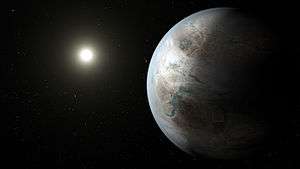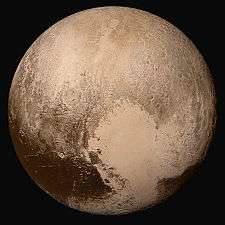K2-3c
| Exoplanet | List of exoplanets
| |||||
|---|---|---|---|---|---|---|
| Parent star | ||||||
| Star | K2-3 | |||||
| Right ascension | (α) | 11h29m20.39s [1] | ||||
| Declination | (δ) | -01d27m17.2s[1] | ||||
| Distance | 137±6.5 ly (42±2[1] pc) | |||||
| Mass | (m) | 0.612±0.086[1] M☉ | ||||
| Radius | (r) | 0.553±0.041[1] R☉ | ||||
| Temperature | (T) | null[1] K | ||||
| Metallicity | [Fe/H] | null[1] | ||||
| Age | null[1] Gyr | |||||
| Physical characteristics | ||||||
| Mass | (m) | 2.1+2.1 −1.3[1] M⊕ | ||||
| Radius | (r) | 1.644+0.160 −0.065[1] R⊕ | ||||
| Density | (ρ) | 1.82+3.00 −0.96[1] g cm−3 | ||||
| Temperature | (T) | 374 K (101 °C; 214 °F) | ||||
| Orbital elements | ||||||
| Semi-major axis | (a) | 0.1405±0.0067[1] AU | ||||
| Eccentricity | (e) | 0.04±0.04[1] | ||||
| Orbital period | (P) | 24.6491±0.0033[1] d | ||||
| Inclination | (i) | 89.70±0.20[1]° | ||||
| Discovery information | ||||||
| Discovery date | 2015 | |||||
| Discoverer(s) | ||||||
| Discovery method | Transit | |||||
| Discovery site | Kepler Space Observatory | |||||
| Discovery status | Confirmed | |||||
K2-3c also known as EPIC 201367065 c is an exoplanet orbiting K2-3 a red dwarf, every 24 days 137 ly away.[1][2] It has a density of 1.82g/cm3 indicating that it could be a Gas dwarf or a Mini-Neptune, it is one of the smallest gas planets ever discovered. Despite not being the smallest planet in the system by radius,[3] by mass it is by far the least massive with a mass only double of that of Earth.[3]
References
This article is issued from Wikipedia - version of the 10/27/2016. The text is available under the Creative Commons Attribution/Share Alike but additional terms may apply for the media files.




